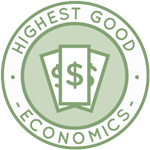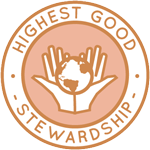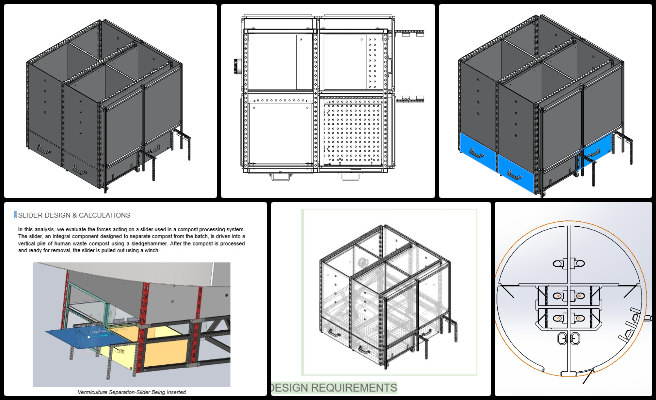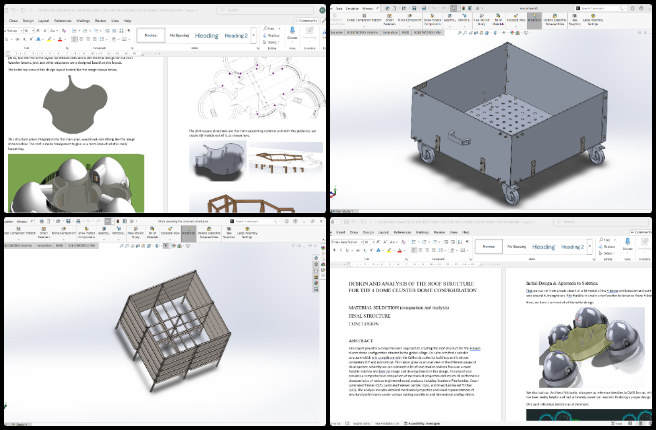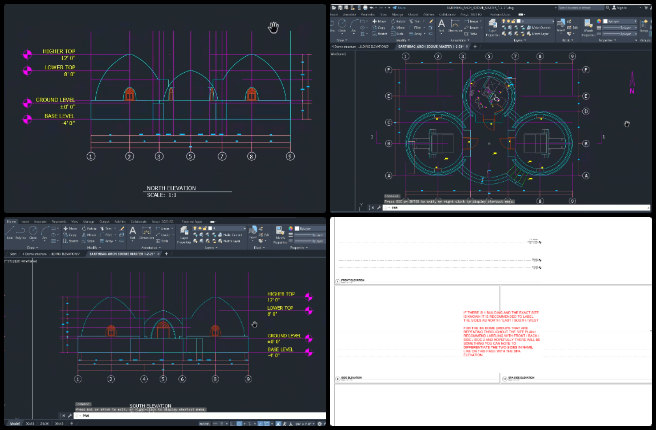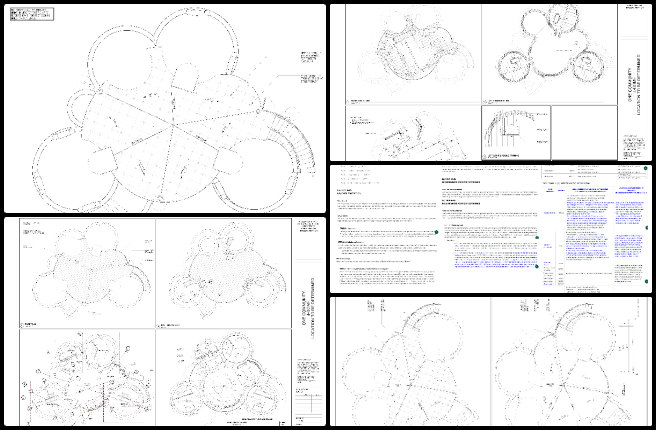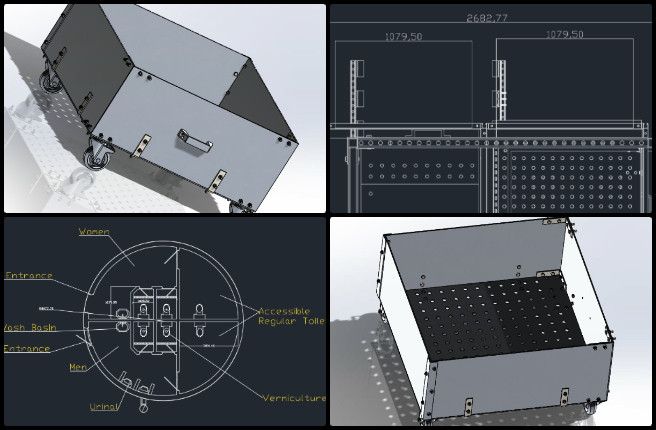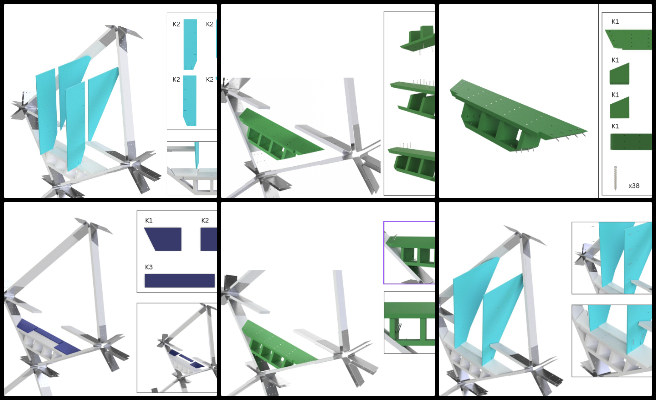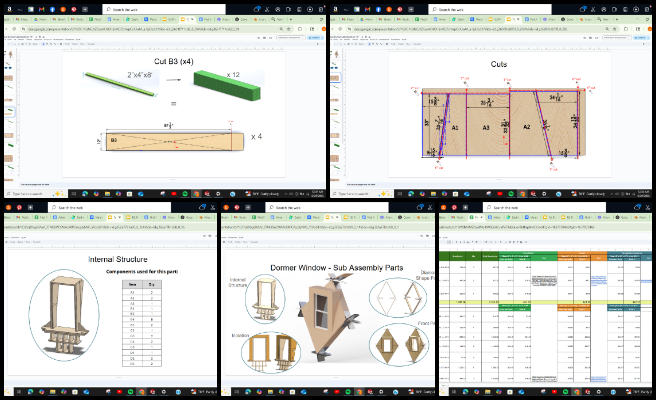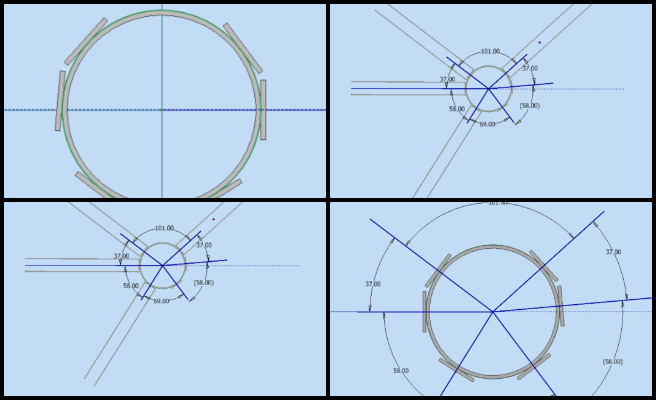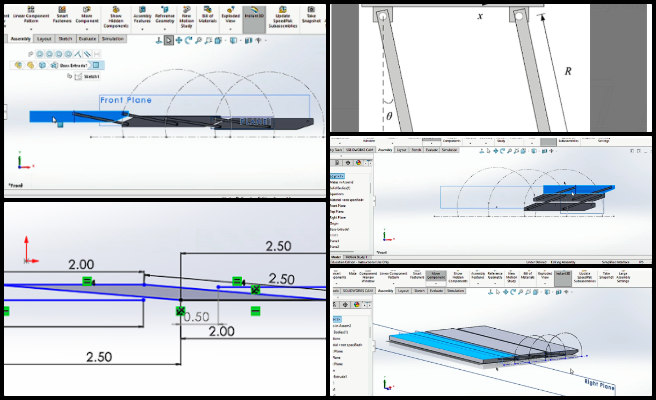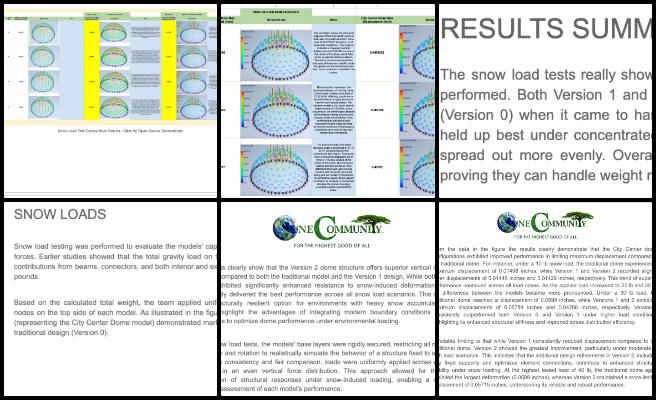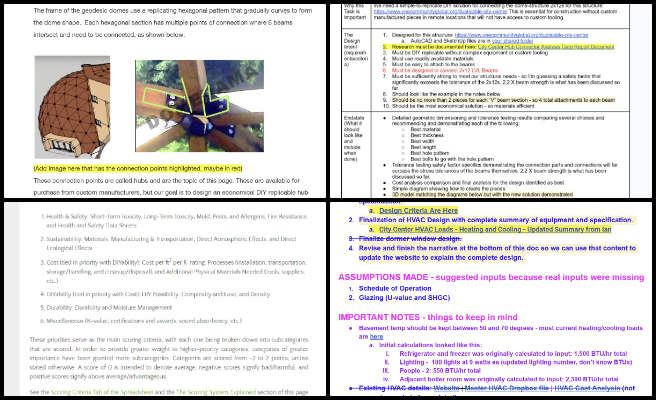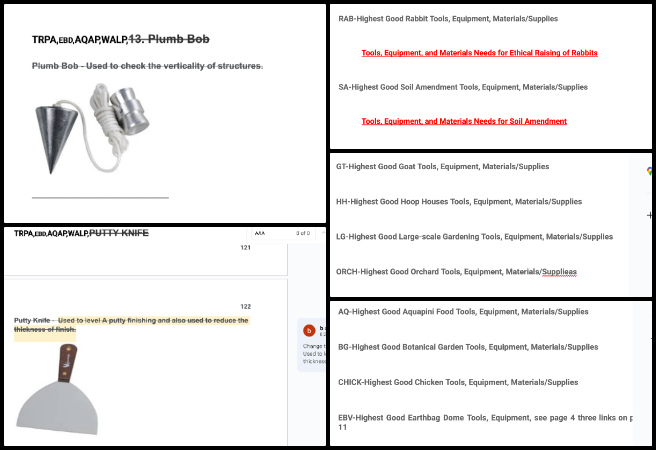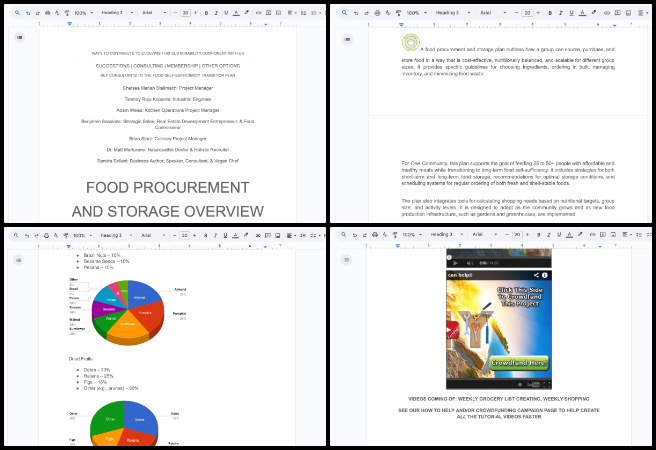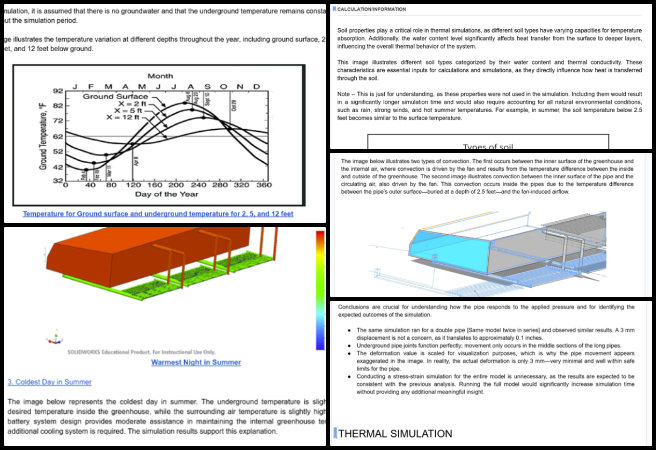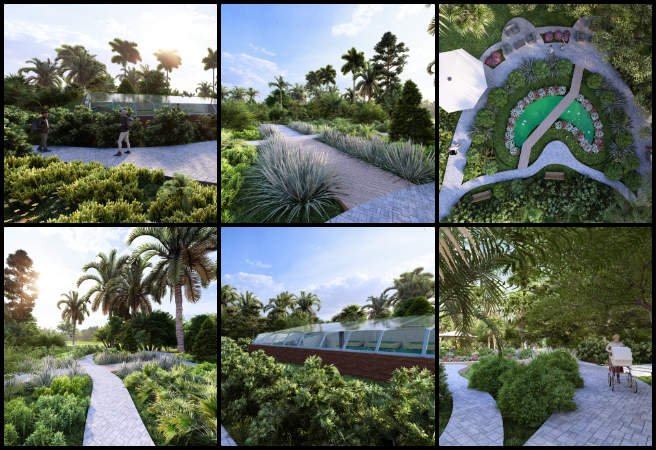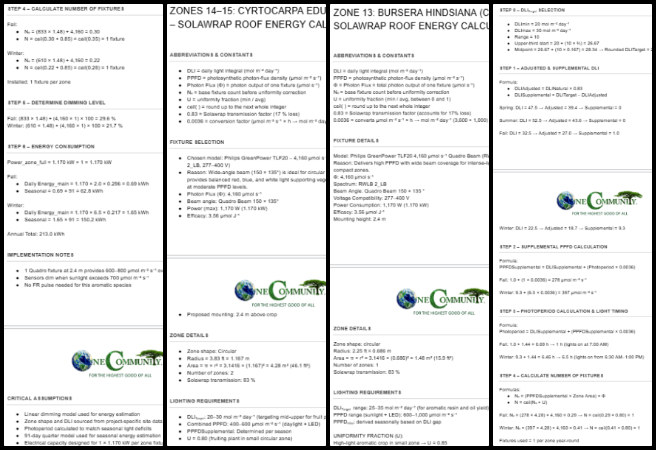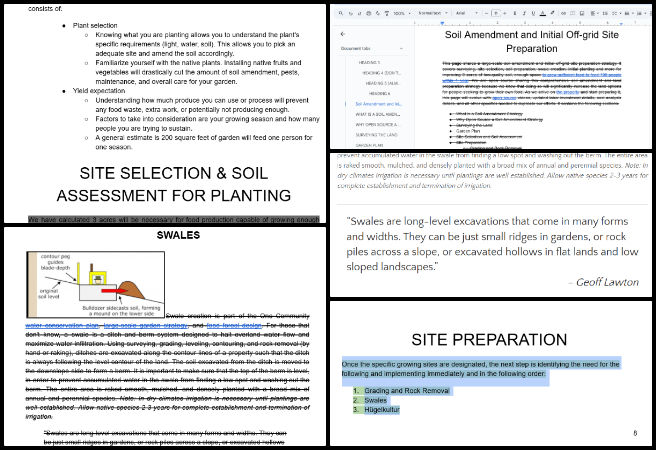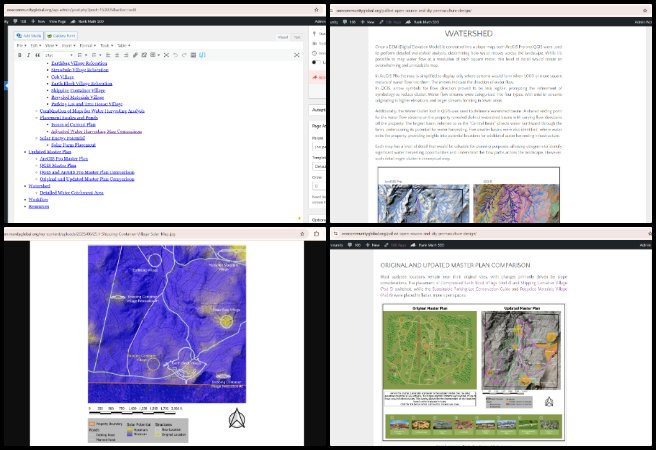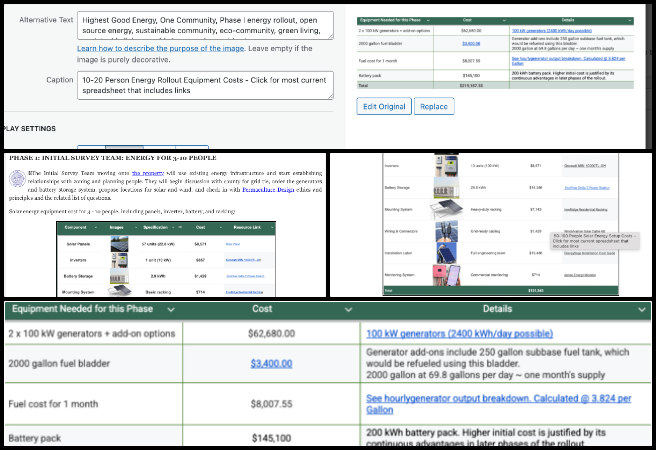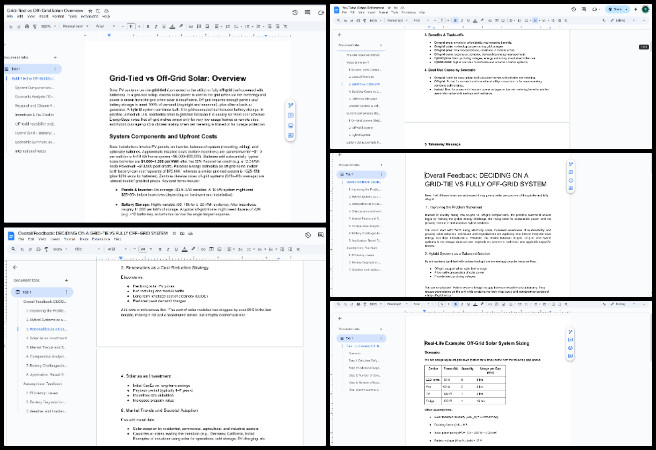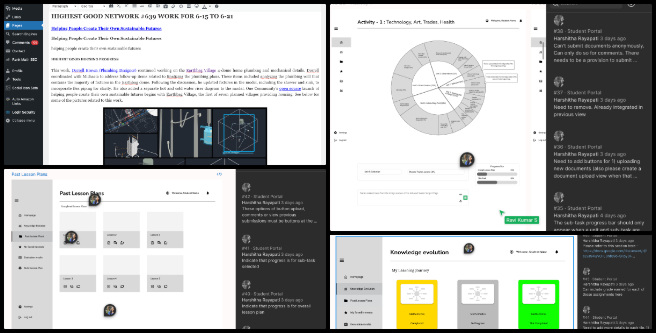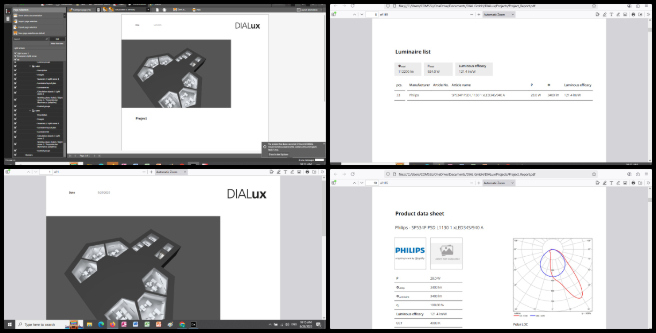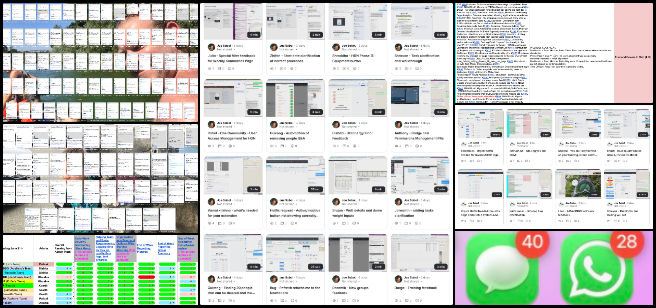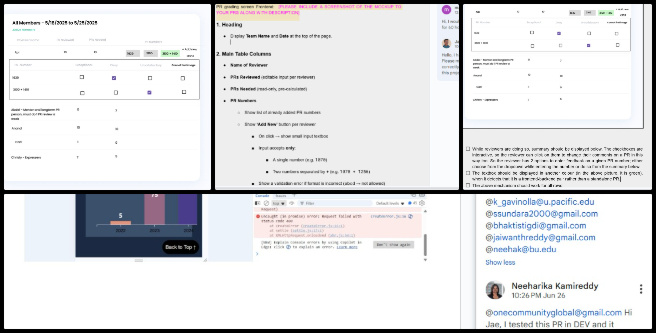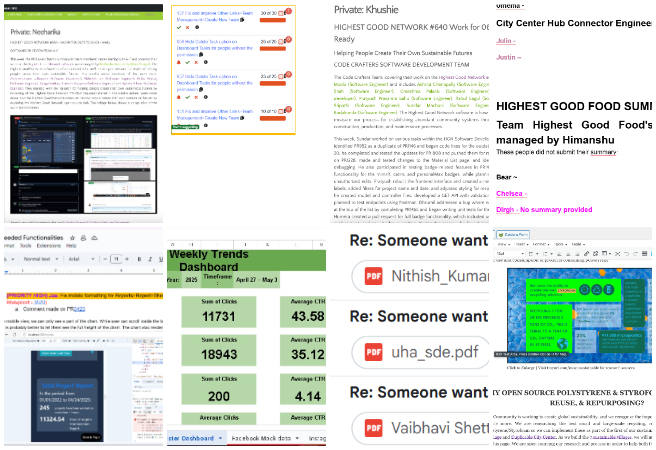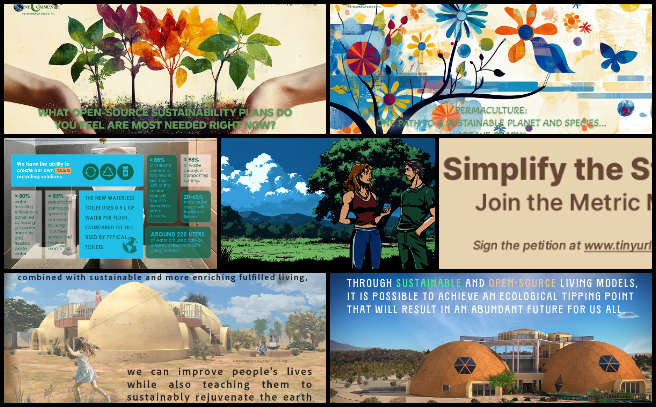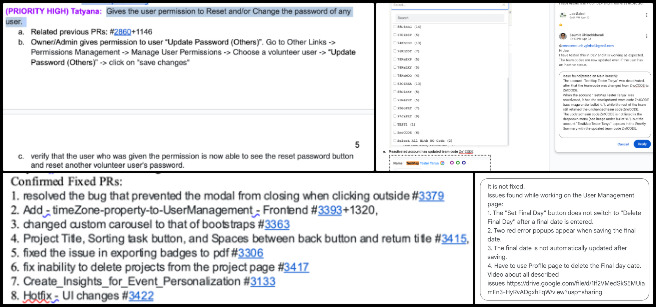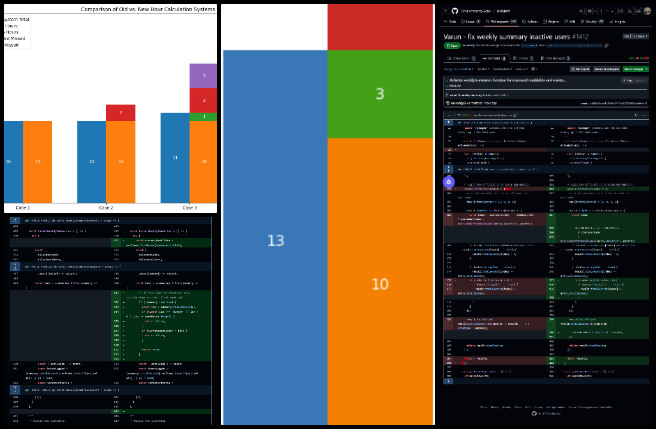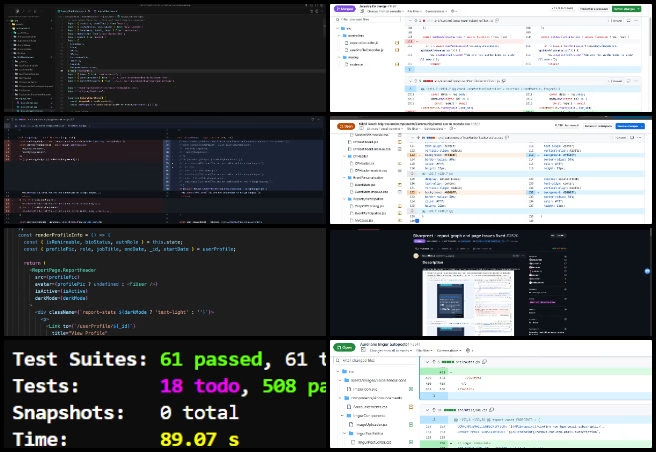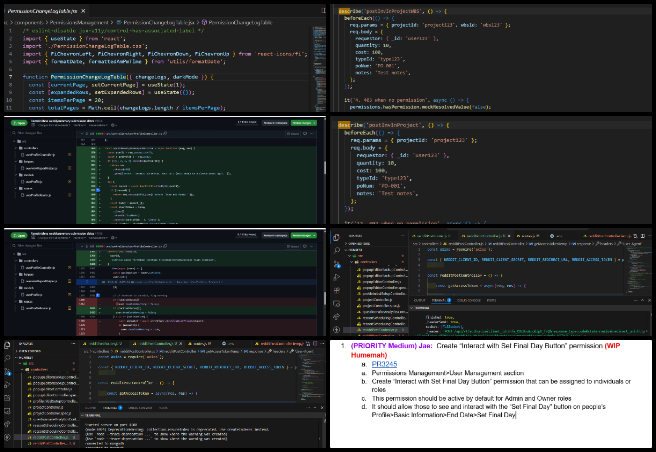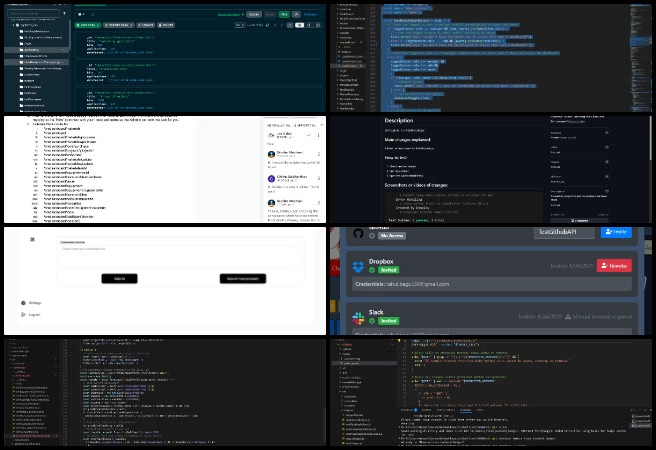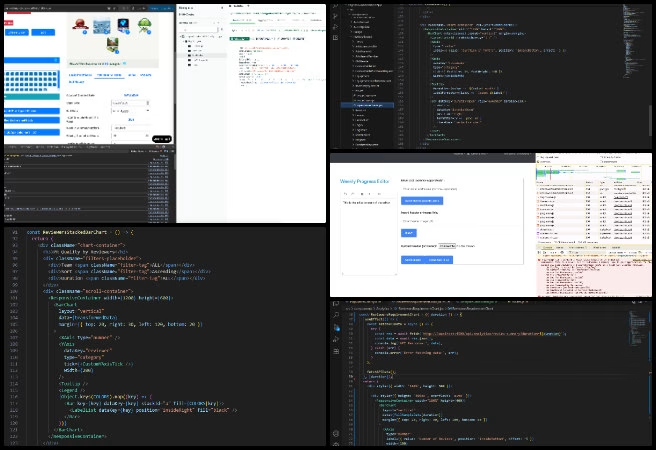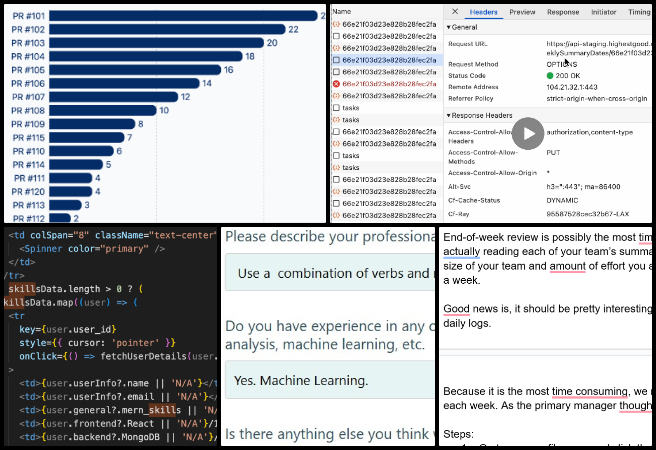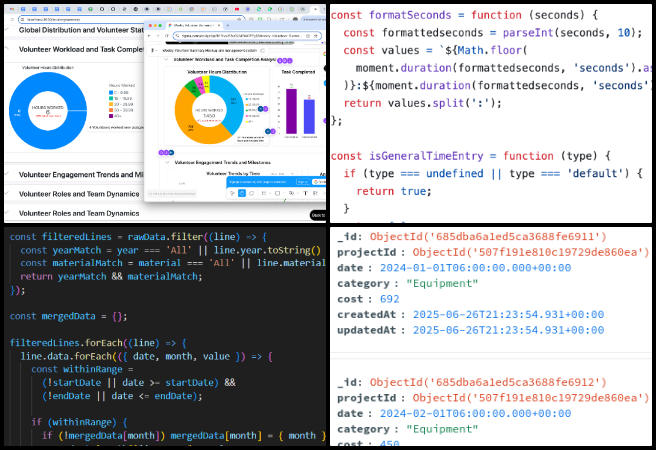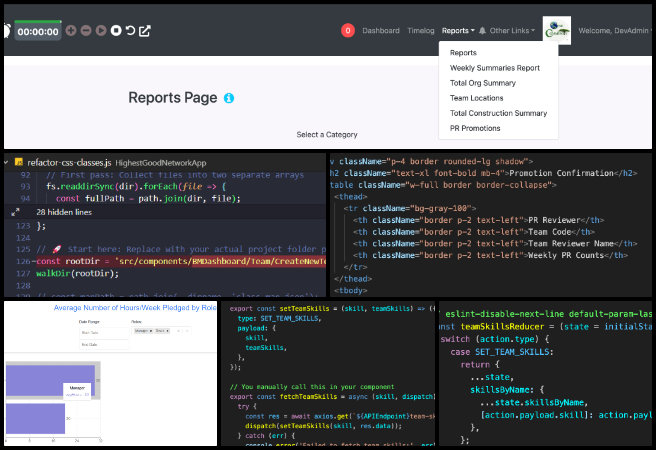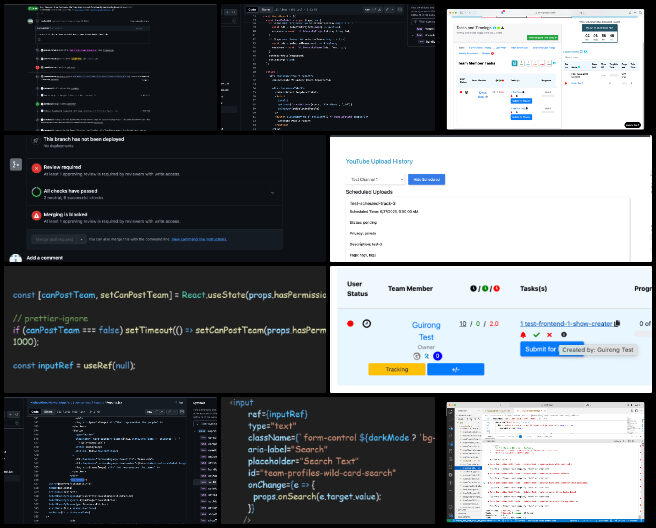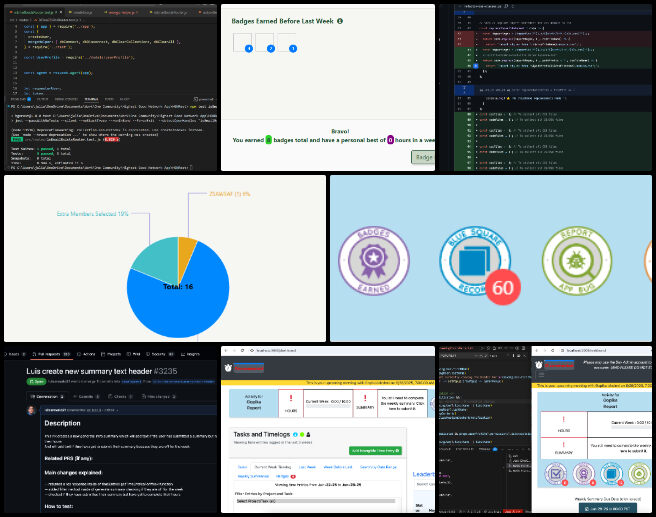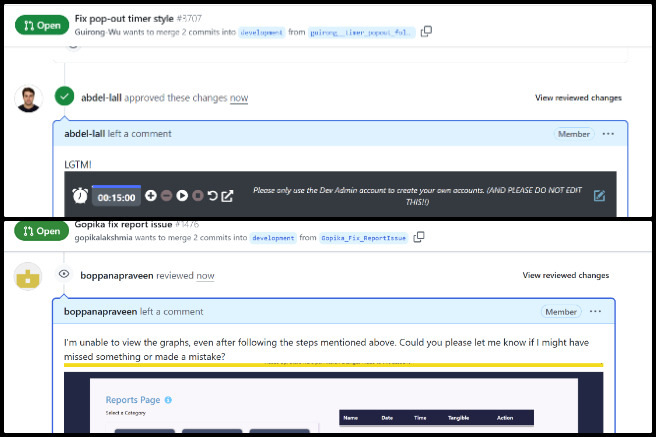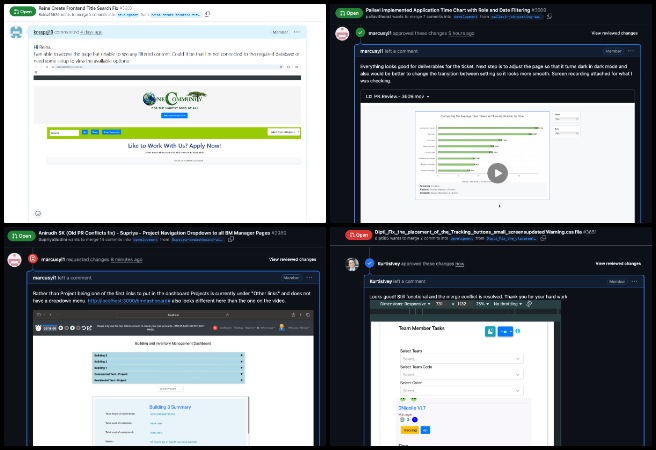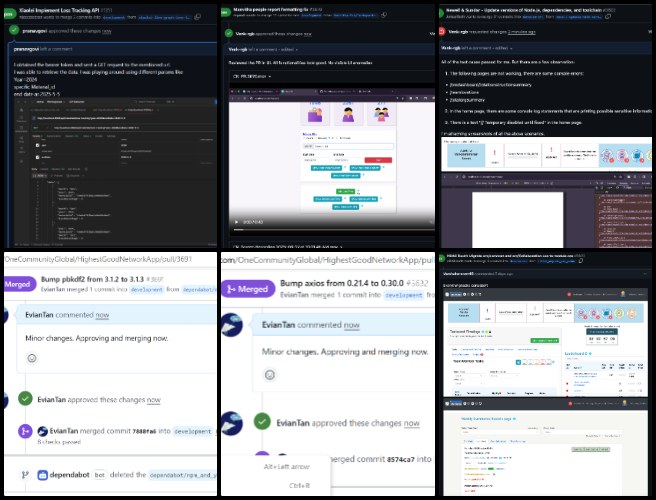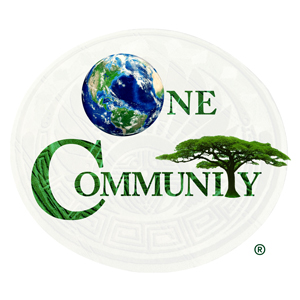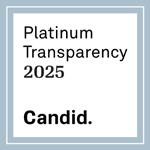Self-replicating Highest Good Creation – One Community Weekly Progress Update #641
At One Community, we are pioneering self-replicating Highest Good creation that demonstrates sustainable approaches to food, energy, housing, education, economics, social architecture, fulfilled living, and global stewardship practices. Built entirely by an all-volunteer team, everything we’re developing is open source and free-shared to support global collaboration and inspire teacher/demonstration hubs around the world. By evolving sustainability and regenerating our planet, we are working to create a world that works for everyone—guided always by the purpose of The Highest Good of All. This is the June 30th, 2025 edition (#641) of our weekly progress update detailing our team’s development and accomplishments.
- Here’s our project overview
- Here’s our world-change methodology
- Here’s how this becomes self-replicating
- Here’s how we are open source and free-sharing all the do-it-yourself designs
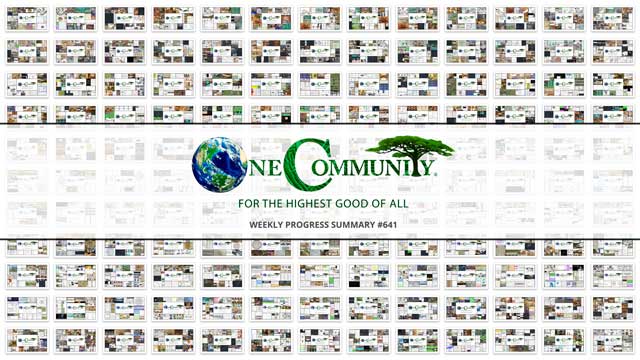
OUR MAIN OPEN SOURCE HUBS
Click on each icon to be taken to the corresponding Highest Good hub page.
One Community’s physical location will forward this movement as the first of many self-replicating teacher/demonstration communities, villages, and cities to be built around the world. This is the June 30th, 2025 edition (#641) of our weekly progress update detailing our team’s development and accomplishments:
Self-replicating Highest Good Creation
One Community Progress Update #641
DONATE | COLLABORATE | HELP WITH LARGE-SCALE FUNDING
CLICK HERE IF YOU’D LIKE TO RECEIVE AN EMAIL EACH WEEK WHEN WE RELEASE A NEW UPDATE
YOU CAN ALSO JOIN US THROUGH SOCIAL MEDIA
ONE COMMUNITY WEEKLY UPDATE DETAILS
HIGHEST GOOD HOUSING PROGRESS
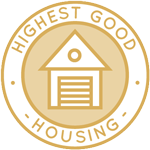 One Community is pioneering self-replicating highest good creation through Highest Good housing that is artistic and beautiful, more affordable, more space efficient, lasts longer, DIY buildable, and constructed with healthy and sustainable materials:
One Community is pioneering self-replicating highest good creation through Highest Good housing that is artistic and beautiful, more affordable, more space efficient, lasts longer, DIY buildable, and constructed with healthy and sustainable materials:
- Learn about: Our Upcoming Crowdfunding Campaign
- Learn about the different village models: 7 Sustainable Village Models
- Visit the open source portals for the first two: Earthbag Village OS Hub | Straw Bale Village OS Hub
This week, Adil Zulfiquar (Engineer) worked on adding and formatting additional content to the Vermiculture Toilet website document, including updates to the slider design, related calculations, and the new version 2 design. He overhauled the operation and maintenance section to include detailed operating procedures. He also collected and compiled a folder of vermiculture design materials for use by the graphics team and participated in discussions with the team regarding the 2D architectural design of the vermiculture system. One Community’s open source launch of self-replicating highest good creation begins with Earthbag Village, the first of seven planned villages providing housing. See below for some of the pictures related to this work.
Karthik Pillai (Mechanical Engineer) worked on the final report for the Earthbag Village 4-dome cluster roof project, incorporating finite element analysis results from earlier stages and refining the structure of the report to align with the finalized roof design and selected materials. This ensured the report clearly presents the design rationale, analytical support, and material choices in a logical and coherent manner. In parallel, he contributed to the design development of the Vermiculture Toilet facility, focusing on the new drawer mechanism. This involved examining options for the drawer’s side-opening feature, which remains under discussion with the team as various design constraints and functional requirements are being considered. Additionally, he was involved in reworking the waste dumping mechanism for the same facility, evaluating modifications to improve efficiency and usability, with the aim of completing this component within the next couple of weeks. As the first of seven planned villages, the Earthbag Village provides the initial housing within One Community’s open source designs for self-replicating highest good creation. See the work in the collage below.
Ketsia Kayembe (Civil Engineer) worked on bringing the three-dome plans to a construction-ready level for the Earthbag Village. She identified the files that needed updates and added details such as correct naming, formatting, and symbols. She reviewed the template and tutorial to compare the drawings and ensure they were consistent with the requirements and standards. One Community’s open source framework of self-replicating highest good creation begins with Earthbag Village, the first of seven planned villages providing housing. See below for some of the pictures related to this work.
Michaela Silva (Architect) continued working on finalizing the interior of the Earthbag Village. She compiled the applicable plumbing code requirements for the roof drainage system and advanced the roof details in the construction documents. She created a new sheet for the roof plans, including an insulation plan and a pedestal plan that show the roof layers. She also completed the loft framing plan and placed it on structural sheet A103. The Earthbag Village is the first of seven villages to be built as part of One Community’s open source model for self-replicating highest good creation. See her work in the collage below.
Tejas Chhajer (Mechanical Engineer) finished the onboarding orientation and began work on the Vermiculture Toilet. Work continued on the AutoCAD floor plan of the vermiculture assembly, including a review of progress during a call with Adil. It was identified that the units of the dimensions needed to be updated to align with U.S. standards. In addition, a new task was assigned involving the design of a removable drawer end to enable easier disposal of waste from the vermiculture toilet. One Community’s open source launch of self-replicating highest good creation begins with Earthbag Village, the first of seven planned villages providing housing. See below for some of the pictures related to this work.
DUPLICABLE CITY CENTER PROGRESS
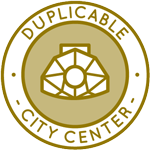 One Community is pioneering self-replicating highest good creation through a Duplicable and Sustainable City Center that is LEED Platinum certified/Sustainable, can feed 200 people at a time, provide laundry for over 300 people, is beautiful, spacious, and saves resources, money, and space:
One Community is pioneering self-replicating highest good creation through a Duplicable and Sustainable City Center that is LEED Platinum certified/Sustainable, can feed 200 people at a time, provide laundry for over 300 people, is beautiful, spacious, and saves resources, money, and space:
- Learn about this building and it’s function: Duplicable City Center Open Source Hub
This week, Andrew Chen (Industrial Designer) continued working on the dormer second-floor window for the Duplicable City Center. He spent time repairing 3D model errors and worked on upgrading the model. New guidance parts were introduced at the base of the window frame to assist with smoother assembly and reduce the need for complicated measurements. He also continued developing the assembly instructions and adjusted the presentation layout to improve visual communication. The Duplicable City Center showcases One Community’s open-source contribution to self-replicating highest good creation. Browse the visuals below.
Ariana Virginia Gutierrez Doria Medina (Industrial Designer) has continued the analysis and cost estimation of the windows for the Duplicable City Center. She worked on the modifications suggested to improve the first documents submitted. Some of these changes included reducing the amount of text, updating the displayed measurements to use fractions instead of decimals, adding providers and images to clarify the assembly process, among other adjustments to maintain the style of the Murphy Bed presentation. Explore how the Duplicable City Center reflects One Community’s open-source approach to self-replicating highest good creation. Check out the photos below.
Nupur Shah (Mechanical Engineer) reworked the Row 2 assembly with new team members and guided them through the ongoing tasks to help them align with the project goals. Due to inconsistencies and missing references in earlier files, all the related part and assembly files for Row 2 had to be recreated from scratch. This involved remaking each component and ensuring proper alignment and positioning in the overall assembly. Conversations with Manjri provided additional clarity on her file structure and design choices, which informed the revisions. As part of the process, adjustments were made to improve how angles and connections were visualized. The next focus will shift toward the beam elements, which will be integrated based on the newly updated Row 2 structure. One Community’s Duplicable City Center is an open-source model for self-replicating highest good creation. Browse the images below.
Sandesh Kumawat (Mechanical Engineer) worked on understanding the design requirements and functional considerations for a spa cover, including exploring insulation configurations and reviewing existing concepts such as thermal blanket layering and folding strategies. He focused on developing a motion mechanism that would allow the spa cover flaps to fold while remaining parallel to the surface, ultimately formulating and modeling a four-bar parallelogram linkage to achieve this motion. Multiple iterations were considered in SolidWorks to refine the placement and length of the linkage arms for correct motion. The formulation included defining the coordinate positions of pivot points and validating that the flap would remain horizontal throughout the motion using equal-length arms. A motion simulation and sketch diagram were created to support the kinematic design, and kinematic equations for position and velocity were also developed for the final concept. Through open-source design, the Duplicable City Center represents a path to self-replicating highest good creation. Browse the photos below to explore this work.
Shu-Tsun (Engineer) continued working on the Duplicable City Center by dedicating her time to conducting the structural and frame analysis of the City Center dome using Autodesk Inventor, as well as working on the spreadsheet for which she is responsible. She has done performed a snow load analysis using real project data to validate and further refine her updated structural model. Her analysis involved detailed simulations and evaluations to ensure the model’s accuracy and reliability under various loading conditions. She also carried out a comparative study of snow loads on different roof geometries, paying special attention to the structural behavior and load distribution differences between flat and dome-shaped roofs. In addition to her technical work, Shu-Tsun dedicated time to drafting the final report. The open-source Duplicable City Center supports One Community’s mission of self-replicating highest good creation. Check out the photos below.
Srujan Pandya (Mechanical Engineer) continued helping with the Duplicable City Center FEA analysis. Updates were made across multiple sections of the dome documentation. The write-up for the DIY Modular Window Designs was reviewed, and a section for integration into the main report was introduced. New headings were added to the main table of contents, and internal links were adjusted to match the site’s formatting conventions. Descriptive images replaced tabular data where applicable, and partial graphics were inserted to assist non-technical readers. A clarification was added about the reduction in unique hub connectors under vertical loads. Source spreadsheet links were included multiple times within relevant sections to improve accessibility. One Community’s open-source Duplicable City Center exemplifies a blueprint for self-replicating highest good creation. Browse the visuals below.
HIGHEST GOOD FOOD PROGRESS
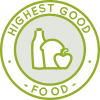 One Community is pioneering self-replicating highest good creation through Highest Good food that is more diverse, more nutritious, locally grown and sustainable, and part of our open source botanical garden model to support and share bio-diversity:
One Community is pioneering self-replicating highest good creation through Highest Good food that is more diverse, more nutritious, locally grown and sustainable, and part of our open source botanical garden model to support and share bio-diversity:
- Learn about the structures: Hoop House Hub | Aquapini & Walipini Open Source Hub
- See what we’ll be growing: Gardens & Hoop Houses | Large-scale Structures | Food Forest | TA
This week, the core team continued updating the shortened abbreviations on the Master Tools, Equipment, and Materials/Supplies document by individual project name and eliminated additional duplicate and unnecessary information. The project names were alphabetized, and all acronyms were finalized and approved by the executive director to ensure consistency between the Master Tools, Equipment, Materials/Supplies document and the website. The Highest Good Food initiative is a key component of One Community’s open source plans, focused on self-replicating highest good creation, and exemplifies the organization’s commitment through innovative design and implementation. Below are some of the images showcasing this work.
Chelsea Mariah Stellmach (Project Manager) continued her work on the Transition Food Self-sufficiency Plan menus and customization spreadsheets. She updated content from the original Food Procurement and Storage Plan webpage and integrated it with Tanmay’s report, including the case study on Mariposa, California. She removed redundant content, provided instructions for backing up videos, adjusted formatting to meet current guidelines, and cleaned up the icon hyperlinks. As an essential aspect of One Community’s open source goals, the Highest Good Food initiative supports self-replicating highest good creation as a foundation for sustainable living. Below are some of the images showcasing this work.
Dirgh Patel (Volunteer Mechanical Engineer) continued assisting with the Climate Battery design evolutions. He edited the final report by adding detailed explanations about soil properties, underground temperature, and the key factors that influence them, replacing some images with written descriptions. He included the concept of convection with clarification of the value used in the simulation and added boundary condition explanations for better understanding. He specified where temperature and convection were applied in the model due to fan-induced airflow. In the results section, he added explanations for all four summer scenarios: warmest day, warmest night, coldest day, and coldest night. Dirgh also added corresponding thermal simulation analyses for the four winter scenarios and included a detailed explanation in the conclusion to help interpret all eight cases. One Community’s open source mission is powerfully reflected in the Highest Good Food initiative, which is focused on advancing self-replicating highest good creation for global benefit. The following visuals highlight key outcomes of this initiative.
Faeq Abu Alia (Architectural Engineer) continued his work on the Earthbag Village. He modeled the southeastern region in SketchUp and exported the model to Lumion, where initial renderings were generated. Following feedback on the southwest region, he updated the Lumion scenes to incorporate terrain features and vegetation, adjusted material settings to match design specifications, and integrated human figures to provide scale in the visuals. One Community’s open source launch of self-replicating highest good creation begins with Earthbag Village, the first of seven planned villages providing housing. See below for some of the pictures related to this work.
Jay Nair (BIM Designer) continued working on Aquapini and Walipini Planting and Harvesting lighting and HVAC design. He proceeded with the lighting energy calculations for the individual zones in Greenhouse Walipini 1. He incorporated updated fixture specifications and zone-specific data to adjust the calculations accordingly. The work aimed to ensure that energy estimates accurately reflect the requirements of each zone while following the standardized format used throughout the project. The Highest Good Food initiative plays a leading role in One Community’s open source platform, promoting self-replicating highest good creation through sustainable and participatory development. Below are some of the images showcasing this work.
Keerthi Reddy Gavinolla (Software Developer) continued enhancing the Highest Good Food page by adding content focused on small-business and urban community solutions. She worked on the Soil Amendment page, cross-checked both the Google Document and the website, and edited the content based on identified differences. Keerthi struck outdated text, updated formatting, adjusted headings, and fixed bullet points. Her focus was on improving structure and readability to ensure consistency between the source document and the live page. Built on One Community’s open source foundation, the Highest Good Food initiative is dedicated to self-replicating highest good creation, empowering communities through self-sustaining systems. Her contributions are showcased in the collage below.
Pallavi Deshmukh (Software Engineer) continued working on adding the new Zenapini 2 content to the Aquapini and Walipini Planting and Harvesting page. She completed six interviews and submitted the required details. She worked on the permaculture page by integrating GIS content provided by Chris, using the web design tutorial as a reference. She checked that all links and images on the page were functioning as expected. Pallavi also created Blog 640 and reviewed contributions from team members, incorporating their work to ensure consistency across the content. In alignment with One Community’s open source objectives, the Highest Good Food project integrates self-replicating highest good creation into a larger vision of regenerative living. Her contributions are highlighted in the collage below.
HIGHEST GOOD ENERGY PROGRESS
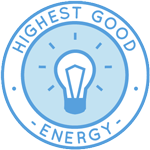 One Community is pioneering self-replicating highest good creation through Highest Good energy that is more sustainable, resilient, supports self-sufficiency and includes solar, wind, hydro and more:
One Community is pioneering self-replicating highest good creation through Highest Good energy that is more sustainable, resilient, supports self-sufficiency and includes solar, wind, hydro and more:
- Learn about the open source sustainable-energy foundations: Solar, Hydro, and Wind
- Explore our research into the most sustainable products and companies for saving water and energy: Insulation, Eco-laundry, Lightbulbs and Light Bulb Companies, Doors and Door Companies, Windows and Window Companies, Toilets, Faucets and Faucet Accessories, Urinals, and more.
This week, Dishita Jain (Data Analyst) continued supporting the Highest Good Energy research and cost analysis for helping people create their own sustainable futures. Her tasks focused on Energy Infrastructure Cost Analysis and Visualizations, where images were resized to fit the webpage specifications, uploaded to WordPress, and captions were added for each image. This included adjusting image dimensions to 640 pixels and integrating them into the relevant documentation. Additional time was spent reviewing training teams as part of OC Administration tasks, where feedback was provided and a summary with a collage was prepared and added to WordPress for both the Blue Steel team and the Binary Brigade team. One Community’s open source mission is powerfully reflected in the Highest Good Energy initiative, which advances self-replicating highest good creation as a model for global benefit. Below are some of the images showcasing this work.
Shravan Murlidharan (Volunteer Electrical Engineer) started contributing to the Highest Good Energy component by assisting with off-grid and grid-tied solar microgrid design. He worked on understanding and comparing solar energy systems, specifically focusing on grid-tied, off-grid, and hybrid configurations. He studied the differences in system design, cost structure, and energy independence associated with each configuration. As part of his technical review, he applied standard formulas to calculate daily energy consumption using a bottom-up approach based on appliance wattage, usage duration, and quantity. He then used this information to determine the required solar panel capacity and the number of panels needed, incorporating real-world factors such as solar irradiance and derating factors. In addition, he explored battery sizing calculations based on system voltage, amp-hour rating, depth of discharge, and the number of backup days required. This work supports One Community’s mission of self-replicating highest good creation.
Shravan also evaluated commonly used assumptions in solar modeling, including 100% efficiency, constant irradiance, and absence of battery degradation, and proposed additional variables to increase model accuracy. He reviewed the functionality and limitations of different inverter types—grid-tied, off-grid, and hybrid—and analyzed how they impact energy flow, system control, and cost. As part of his research, he watched and summarized educational videos comparing solar system types and inverter configurations, extracting technical points relevant to system selection and usage scenarios. He generated discussion questions based on graphs and assumptions, commented on methodology slides, and prepared formatted calculations for documentation. He began outlining a report titled Grid-Tied vs Off-Grid Solar: Overview from My Perspective, aimed at presenting key technical and economic comparisons from a practical standpoint, including system selection criteria and potential application contexts. Guided by its open source philosophy, One Community developed the Highest Good Energy initiative to pioneer sustainable solutions by self-replicating highest good creation. His contributions are shown in the collage below.
HIGHEST GOOD EDUCATION PROGRESS
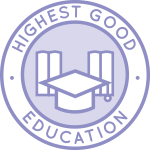 One Community is pioneering self-replicating highest good creation through Highest Good education that is for all ages, applicable in any environment, adaptable to individual needs, far exceeds traditional education standards, and more fun for both the teachers and the students. This component of One Community is about 95% complete with only the Open Source School Licensing and Ultimate Classroom construction and assembly details remaining to be finished. We’ll report on the final two elements to be finished as we develop them. With over 8 years of work invested in the process, the sections below are all complete until we move onto the property and continue the development and open sourcing process with teachers and students – a development process that is built directly into the structure of the education program and everything else we’re creating too:
One Community is pioneering self-replicating highest good creation through Highest Good education that is for all ages, applicable in any environment, adaptable to individual needs, far exceeds traditional education standards, and more fun for both the teachers and the students. This component of One Community is about 95% complete with only the Open Source School Licensing and Ultimate Classroom construction and assembly details remaining to be finished. We’ll report on the final two elements to be finished as we develop them. With over 8 years of work invested in the process, the sections below are all complete until we move onto the property and continue the development and open sourcing process with teachers and students – a development process that is built directly into the structure of the education program and everything else we’re creating too:
- Program Overview: Education Open Source Hub
- How the components work together in designing human orchestrated eco-abundance: How to use the Education for Life Program
- Lesson Plans for Life – Lesson Plans How-to
- Foundations of Outstanding Leaders, Teachers, and Communicators
- Curriculum for Life
- Teaching Strategies for Life
- Learning Tools and Toys for Life
- Evaluation and Evolution
This week, Harshitha Rayapati (Program Manager) continued work on detailing deliverables for the Highest Good Education software platform, outlining various components, developing Figma designs, and expanding the visual layout of the student dashboard. She provided detailed comments on various sections of the student dashboard design files, including the knowledge evolution view, past lessons view, and detailed activity view. She contributed to enhancing the evaluation results page by expanding its component documentation and aligning its features with the teacher portal’s grade posting tool. Harshitha also worked on the “build a lesson plan” view, offering suggestions to refine the layout and functionality. Feedback was given on Ravi’s student dashboard designs to ensure consistency with the software component documentation. In addition, she compiled the weekly blog update, reviewed the Housing Team’s progress, edited the blog page, and created a visual collage for the update. The One Community model of self-replicating highest good creation, exemplified by sustainably built classrooms like this, represents sustainable change for the whole planet. See the collage below for her work.
Mai Mohamed (Electrical Engineer) continued working on drawing the building and its rooms, determining the story heights, and establishing the scale and X-Y coordinates to add spaces identified as classrooms. She generated the report using the documentation menu by navigating to the reporting section of the software, selecting the relevant project data, configuring the output settings to match the required specifications, and reviewing the selected content for consistency. She finalized the process by exporting the report in the correct format and saving it for internal team use. Sustainably built classrooms like this exemplify the One Community model of self-replicating highest good creation driving global sustainable change. See the collage below for her work.
HIGHEST GOOD SOCIETY PROGRESS
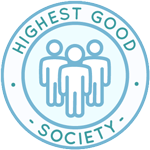 One Community is pioneering self-replicating highest good creation through a Highest Good society approach to living that is founded on fulfilled living, the study of meeting human needs, Community, and making a difference in the world:
One Community is pioneering self-replicating highest good creation through a Highest Good society approach to living that is founded on fulfilled living, the study of meeting human needs, Community, and making a difference in the world:
- Read the Highest Good society overview: Highest Good Society
- Learn about the model for fulfilled living and sharing: A Day in the Life
- Learn about the 4 economic models: RBE | For-profit | Non-profit | Entrepreneurship
- Learn about our open source community collaboration and management software: The Highest Good Network
This week, the core team completed over 44 hours managing One Community’s volunteer-work review not included above, emails, social media accounts, web development, new bug identification and bug-fix integration for the Highest Good Network software, and interviewing and onboarding new volunteer team members. They also shot and incorporated the video above that explains how self-replicating highest good creation is a foundation of the bigger picture of everything One Community is doing. The image below shows some of this work.
Govind Sajithkumar (Project Manager) continued focusing on analytics and content management for Facebook and Instagram on Meta platforms. He handled the weekly content cycle for Meta platforms by preparing, scheduling, and publishing new posts for Facebook and Instagram. He populated the content calendar and logged all post information, including metadata and media types, in the Open Source tracking spreadsheet. Govind also completed the weekly update for the social media analytics spreadsheet, refreshing it with the latest audience demographics, performance metrics, and engagement statistics for both platforms. Additionally, he performed PR Review Team Management by providing feedback on team members’ documents, updating the WordPress site with the team’s weekly summary and collage, and filling in the PR Review Team Table and HGN PR spreadsheet. This effort supports One Community’s broader mission of self-replicating highest good creation. The images below showcase some of this work.
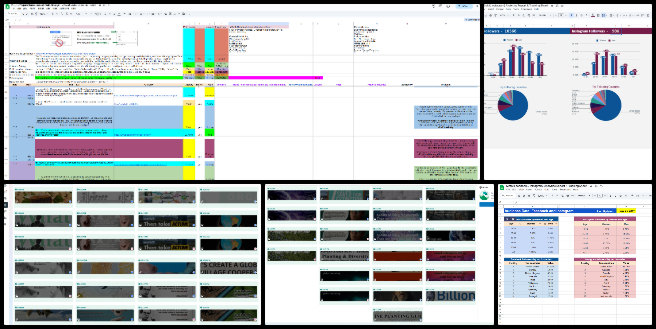
Jaiwanth Reddy Adavalli (Project Manager) continued developing the Job Applicants page along with components of the Highest Good Network Phase 2 and Phase 4 dashboards, including the PR Team analytics section. He focused on testing several PRs in the Highest Good Network software and continued work on the development of the PR Review Team Analytics software and dashboard. He updated the corresponding Figma wireframes, made changes to some action items, and discussed task management of the Analytics software with Neeharika. As part of the PR Review Team, Jaiwanth reviewed the pull requests of the volunteer team assigned to him. This project plays an important role in One Community’s commitment to self-replicating highest good creation. The following images show his work for the week.
ADMINISTRATION TEAM
The Administration Team summary, covering their work administrating and managing most of One Community’s ongoing process for self-replicating highest good creation was managed by Bhakti Tigdi (Project Manager) and includes Anuneet Kaur (Administrator), Himanshu Mandloi (Engineering Project Manager), Khushie Zaveri (Communication Strategist), Neeharika Kamireddy (Data Analyst), Olawunmi “Ola” Ijisesan (Administrative and Management Support), Olimpia Borgohain (Data Analyst and Team Administrator), Rachna Malav (Data Analyst), and Rishi Sundara (Quality Control Engineer and Team Administrator). The Highest Good Network software is how we will be managing and objectively measuring our process for self-replicating highest good creation through our social architecture, construction, production, and maintenance processes.
This week, the Administration team contributed to various operational, communication, and content tasks that supported the organization’s project management, outreach, and sustainability goals. Anuneet researched resources for sustainable insulation, updated and optimized web content and graphics based on team feedback, managed volunteer bios, and began drafting content for the Licensing and Accreditation page of the Highest Good Education Program. This progress is part of One Community’s work toward self-replicating highest good creation. Himanshu reviewed daily timelogs, followed up with team members on pending tasks, adjusted time entries as needed, and created a new construction-related task for the Earthbag Village project. He also developed a blog post and reviewed admin evaluations. Khushie expanded the metric system social media campaign with platform-specific content, added calls to action, coordinated graphics requests, and handled weekly admin tasks like editing summaries and backend documentation formatting. This contribution aligns with One Community’s mission of self-replicating highest good creation.
Neeharika monitored task assignments for the software development team by reviewing estimated hours and assigning work accordingly, tested pull requests, and completed her admin responsibilities. Ola supervised the pull request team, managed folder and image uploads, maintained admin team workspaces, and updated documentation to ensure reporting consistency. Olimpia worked on App Script development to automate post tracking for the social media dashboard, completed admin duties, and corrected issues in her blog content. Rachna focused on ongoing SEO content updates and responded to team communications but did not conduct interviews due to scheduling conflicts. Rishi created and uploaded team collages, consolidated individual blogs into the main weekly post, completed SEO work, and tested several development pull requests while assigning follow-ups for pending items. This work contributes to One Community’s commitment to self-replicating highest good creation. See below to view images of their work.
GRAPHIC DESIGN TEAM
The Graphic Design Team’s summary includes Aurora Juang (Graphic Designer), Junyuan Liu (Graphic Designer, UI/UX Designer), Yulin Li (Graphic Designer), Qinyi Liu (Graphic Designer), and Rutal Deshmukh (Graphic Designer), covering their work on graphic designs for self-replicating highest good creation.
This week, Aurora produced 12 social media posts, maintaining brand consistency and supporting audience interaction as part of the self-replicating highest good creation. The content aligns with the brand’s tone and contributes to a cohesive feed. Junyuan created social media content by collecting images, exploring design options, and adjusting the layout for the “Most Sustainable” image. He also documented key details for the next designer and explored ideas for future image creation. Rutal updated previous social media graphics, created new ones along with Metric Campaign logo variations for Week 4, and contributed to self-replicating highest good creation. She saved all work in the respective folders and is waiting for feedback.
Yulin created social media posters from village renderings, applied formatting standards, and submitted them for feedback. Qinyi began work on Wednesday, reviewed materials, and identified missing details like login access and photo requirements, while contributing to self-replicating highest good creation. She created and refined a game-style social media image in Photoshop, adjusting visuals and layout based on feedback and suggestions. See the Highest Good Society pages for more on how this contributes to self-replicating highest good creation. See the collage below to view some of their work.
HIGHEST GOOD NETWORK PROGRESS
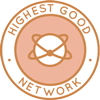 One Community is pioneering self-replicating highest good creation through open source Highest Good Network® software that is a web-based application for collaboration, time tracking, and objective data collection. The purpose of the Highest Good Network is to provide software for internal operations and external cooperation. It is being designed for global use in support of the different countries and communities replicating the One Community sustainable village models and related components.
One Community is pioneering self-replicating highest good creation through open source Highest Good Network® software that is a web-based application for collaboration, time tracking, and objective data collection. The purpose of the Highest Good Network is to provide software for internal operations and external cooperation. It is being designed for global use in support of the different countries and communities replicating the One Community sustainable village models and related components.
- Learn about our open source community collaboration and management software: The Highest Good Network
This week, the core team continued their work on the Highest Good Network pull requests and confirmed the following fixes: the modal now closes when clicking outside (#3379); the timeZone property was added to User Management in the frontend (#3393 and #1320); the custom carousel was replaced with Bootstrap’s carousel (#3363); updates were made to the project title, sorting task button, and spacing between the back button and return title (#3415); the issue with exporting badges to PDF was resolved (#3306); projects can now be deleted from the project page (#3417); insights for event personalization were created (#3133); and UI changes were implemented in a hotfix (#3422). This action reflects One Community’s dedication to self-replicating highest good creation.
The following issues remain unresolved: code replacement for inactive users (#3398 and #1324); user permissions for resetting and changing passwords (#2860 and #1146); and accuracy of first and last day data with auto-refresh on deactivation, for which issues were documented in a video (Bhavpreet PR3176 and PR3387). Additional work included assigning tasks to four volunteers, creating a record for the issue where a user with the appropriate permissions could not reset or change another user’s password, and noting that testing could not be completed for PR #1222 (fix lead team badge auto-assignment) due to a bug preventing the creation of a new team. These efforts represent incremental progress in helping people create their own sustainable futures. See the Highest Good Society and Highest Good Network pages for more on how this aligns with One Community’s commitment to self-replicating highest good creation. The collage below shows some of this work.
ALPHA SOFTWARE DEVELOPMENT TEAM
The Alpha Software Team, covering their progress on the Highest Good Network software, was managed by and includes Nikita Kolla (Full Stack Developer) and Varun Reddy Mogili (Software Engineer). This software is an internal management and communication platform with the goal of self-replicating highest good creation.
This week, Varun resolved merge conflicts in pull requests #1412 and #3554, fixed test failures, and improved report generation to stabilize the weekly summary reporting system, supporting the self-replicating highest good creation. He addressed conflicts between the development branch and his branch to ensure both sets of features functioned correctly. Nikita addressed the processing of Core Team members’ additional hours by identifying issues in the codebase, learning the bulkwrite function, and creating a standalone Python snippet to later convert into JavaScript. See the Highest Good Society and Highest Good Network pages to learn more on how this relates to self-replicating highest good creation. See some of the team’s work in the collage below.
BINARY BRIGADE SOFTWARE DEVELOPMENT TEAM
The Binary Brigade Team’s summary, overseeing advancements in the Highest Good Network, was managed by Aureliano Hubert Maximus (Volunteer Software Engineer) and includes Amalesh Arivanan (Software Engineer), Anirudh Sampath Kumar (Software Developer), Geeta Matkar (Software Engineer), Jaissica Hora (Software Engineer), Nikhil Routh (Software Engineer), Ramsundar Konety Govindarajan (Software Engineer), Vamshi Gutha (Full-Stack Developer), and Samman Baidya (Software Engineer). The Highest Good Network software is how we’ll be managing and objectively measuring our progress in self-replicating highest good creation through our social architecture, construction, production, and maintenance processes.
This week, Jaissica reviewed and reported several high-priority issues ahead of the next production release, including a bug where the “Share PDF” button broke the Total Construction Summary page. She reviewed the UI/UX elements on that page, documented related issues, resolved a major merge conflict on the main branch, addressed linting errors, and fixed failing tests. Samman began work on a Phase III task involving both front-end and back-end development for an event reschedule button. He reviewed the prior pull request, added the button near event details, set up the modal structure, and began implementing logic to handle dynamic date inputs and create necessary endpoints. Nikhil migrated legacy CSS files to CSS Modules, updated JSX files, resolved merge conflicts in PRs 3639, 3640, 3643, and 3644, and merged changes to development. Vamshi built a line chart component for the Phase 2 Summary Dashboard to visualize injury trends over time, enabling filtering by project and date with severity levels color-coded and responsive layout adjustments. This result is in line with One Community’s pursuit of self-replicating highest good creation.
Sabitha explored Chart.js for a horizontal bar graph, scaffolded the backend with new routes, added role-based pledge logic, encountered a frontend issue while wiring up the Bitly UI, and continued building the Bitly-posting interface. Anirudh finalized multiple pull requests—PRs 3079, 2989, 1850, and 1793—in preparation for his departure by resolving merge conflicts and addressing reviewer comments. Amalesh resolved merge conflicts for PRs 1444 and 3573, rewrote test cases for a new PR 1480, debugged code, fixed the Projects/People/Teams page design for narrow screens, documented with screenshots and videos, and ensured onboarding compliance. Ramsundar fixed an issue in the “Current Week: a/b” component so data displays only for the user’s own page, resolved a Project page rendering issue caused by invalid HTML structure introduced in PR 3520, and addressed a refresh-related bug that redirected users to the dashboard by ensuring permission data is retained. Geeta investigated people report miscalculations for users logging more than 10 hours, reviewed the frontend and backend logic, updated the count logic, and adjusted the layout for half-screen display. See the Highest Good Society and Highest Good Network pages to learn more about how this work relates to self-replicating highest good creation. View some of the team’s work in the collage below.
BLUE STEEL SOFTWARE DEVELOPMENT TEAM.
The Blue Steel Team’s summary, presenting their work on the Highest Good Network software, was managed by Sheetal Mangate (Software Engineer) and includes Humemah Khalid (Software Engineer/Backend Developer), Linh Huynh (Software Engineer), and Ramakrishna Aruva (Software Engineer). The Highest Good Network software is how we’ll be managing and objectively measuring our process for self-replicating highest good creation.
This week, Humemah worked on creating the “Interact with Set Final Day Button” permission as part of PR3245. This new permission was added under the Permissions Management > User Management section and is designed to control access to the “Set Final Day” button found on a person’s profile under Basic Information > End Date. The permission can be assigned to both individuals and roles and is enabled by default for Admin and Owner roles. When active, it allows users to view and interact with the “Set Final Day” button. This task supports the self-replicating highest good creation framework led by One Community. Linh completed unit tests for two controller files in the backend of the HGN application. For the file bmMaterialsController.js, all test cases were implemented and validated. For emailController.js, Linh resolved test issues related to the cheerio library and mocked the HTML parsing behavior. A new branch for inventoryController.js was then created and pushed, where 55 unit test cases were designed and implemented across five parts. These tests covered major logical branches such as permission checks, valid and invalid input scenarios, database errors, and conditional logic for creation and updates. Most of the tests are passing, with the remaining ones being debugged due to mocking inconsistencies and module path issues. Multiple commits were made to track progress and reflect partial completion. This work ties into One Community’s broader self-replicating highest good creation model.
Ramakrishna identified a design issue in previous work where summary data was stored in an array, leading to potential duplicate keys. To address this, the UserProfile model was refactored to use a map for storing summarySubmissionDates, and a new method was added separately to maintain clarity. A new router was created for the updated API endpoint, followed by testing and a pull request submission. He also updated the frontend components to connect them with the revised backend API and resolved merge conflicts in a previous pull request by switching to the affected branch and pushing the updated changes. Sheetal worked on Reddit application-only OAuth and found that it provides only read access, which results in an error when attempting to post due to missing user-context authorization. Since submitting a post requires browser interaction and a redirect URL, she began exploring how to implement OAuth with user authentication. See the Highest Good Society and Highest Good Network pages to learn more about how their work contributes to self-replicating highest good creation. See below to view images of their work.
CODE CRAFTERS SOFTWARE DEVELOPMENT TEAM
The Code Crafters Team, covering their work on the Highest Good Network software, was managed by Sai Moola (Software Engineer) and includes Ashrita Cherlapally (Software Engineer), Dhrumil Dhimantkumar Shah (Software Engineer), Greeshma Palanki (Software Engineer), Humera Naaz (MERN developer), Rahul Bagul (Software Engineer), Ravikumar Sripathi (Software Engineer), and Sundar Machani (Software Engineer). The Highest Good Network software is how we’ll manage and objectively measure our process for establishing abundant community systems through our social architecture, construction, production, and maintenance processes. This work ties into One Community’s broader self-replicating highest good creation model.
This week, Ashrita worked on implementing a job analytics dashboard that visualizes application counts across roles using a horizontal bar chart. She created a backend route to support filtering by date range, selected roles, and time granularity, and integrated it with the frontend using dynamic API queries. On the frontend, she addressed rendering problems by dynamically adjusting the chart height based on data length and repositioning the Y-axis title to avoid overlapping labels. This task supports the self-replicating highest good creation framework led by One Community. Dhrumil focused on unit testing, completing test cases for AddMaterial.jsx in PR #3708 and implementing necessary changes for AddTeamMember.jsx, submitted under PR #3695. Greeshma implemented a reusable canUserEditTask utility function to enforce role-based edit permissions, and it was integrated into task-related components to restrict unauthorized edits and display relevant messages. A runtime error caused by attempting to access properties of an undefined object, which was preventing the webpage from loading, was resolved by updating the useEffect logic. This work contributes to One Community’s commitment to self-replicating highest good creation. A SyntaxError: Unexpected token ‘<‘ resulting from an HTML error page being treated as JSON was also addressed by fixing the related fetch request. Work was initiated on PR2196, focusing on updating the logic to automatically assign a user’s end date based on the last day of the week they logged hours. This effort supports One Community’s focus on self-replicating highest good creation. Humera implemented backend logic for function streak badge assignment and added commit protection to critical badge scheduler functions through Husky in PR #1479. The logic included badge incrementing, replacement, and conditional removal or decrement of lower-level badges, with testing facilitated via local setup and Postman. She also documented the procedure for verifying commit protection by attempting to modify protected functions. This work ties into One Community’s broader self-replicating highest good creation model.
Rahul worked on automating user access management across Dropbox, Slack, Sentry, and GitHub, starting with backend investigation and issue resolution. He acquired necessary credentials, validated API functionality, and restructured the frontend UI to improve usability. Features added include individual and bulk invite and revoke options, along with a new MongoDB schema to track user invite status, enabling real-time access visibility in the UI and preparing the feature for team testing. This contribution aligns with One Community’s mission of self-replicating highest good creation. Ravi focused on enhancing the UI of the Activity Page to improve user experience and functionality. He introduced a clear separation between the unit and section selection components, making the navigation process more intuitive. The individual sub-task progress bar was removed to streamline the interface. He updated the dropdown menus for both unit and section selections, ensuring that once both are selected, the relevant sub-tasks and their associated progress bars appear dynamically. Ravi also added new UI elements, including buttons for uploading documents, accessing external or internal links, and redirecting users to the comments and feedback sections. Furthermore, he redesigned the upload and comments pages for a more user-friendly experience. Notably, he implemented a feature in the feedback section that allows students to submit comments anonymously. This progress is part of One Community’s work toward self-replicating highest good creation. Sai worked on the Phase 2 Summary Dashboard by completing the frontend for a bar graph visualizing project risk profiles using react-select for dropdowns, then shifted to backend development by creating a new schema linked to the issues schema, building a controller to handle CRUD operations and profile generation, and verifying the endpoints, with continued work on the getRiskProfileSummary endpoint. Sundar worked on resolving merge conflicts in PRs #3675, #3609, and #3433 in the HighestGoodNetworkApp repository, as well as PRs #1409, #1503, and #1502 in the HGNRest repository. He also assisted a peer with fixing CI build failures in PRs #3609 and #3675. He continued development on dark mode support for BM dashboard components, focusing on the material list page, and completed coding and testing for PR #1228, though production build issues remain. Additionally, he completed updates to badge scheduler logic functions, including checkPersonalMax, checkMinHoursMultiple, checkTotalHrsInCat, checkXHrsForXWeeks, and checkNoInfringementStreak, and pushed the changes to PR #1479. This action reflects One Community’s dedication to self-replicating highest good creation. See the Highest Good Society and Highest Good Network pages for more on how this relates to self-replicating highest good creation. View some of the team’s work in the collage below.
DEV DYNASTY SOFTWARE DEVELOPMENT TEAM
The Dev Dynasty Team’s summary, covering their work on the Highest Good Network software, was managed by Zhifan Jia (Software Engineer) and includes Dharmik Patel (Software Engineer), Manvitha Yeeli (Software Engineer), Mohan Satya Ram Sara (Software Engineer), Shraddha Shahari (Software Engineer), Vamsi Krishna Rolla (Software Engineer), and Vaibhav Koladiya (Software Engineer). The Highest Good Network software is how we’ll manage and objectively measure our process for establishing abundant community systems through our social architecture, construction, production, and maintenance processes.
This week, Dharmik finalized the implementation of the team code filter set functionality associated with PR1274. He addressed multiple backend issues, including saving filter sets to the database and modifying the character limit for filter names from five to seven. He also applied several fixes based on feedback provided earlier in the week, such as refining the backend logic and ensuring proper persistence of saved filters. This action reflects One Community’s dedication to self-replicating highest good creation. Dharmik continued testing the backend changes across several days and completed the weekly summary and video documentation for the work done. Manvitha fixed an issue in PR3697 where start and end dates showed as “N/A” in the People Report due to missing data and resolved a display problem in PR3670 by updating selector logic to group time entries by projectId for correct pie chart rendering. She created a PR Review Team Analytics Dashboard with two charts, implemented a shared dropdown duration filter, removed redundant internal filters, styled the charts, and added scroll support. She attempted to integrate the reviewers chart API but encountered authorization issues and contacted the team for clarification. This result is in line with One Community’s pursuit of self-replicating highest good creation. Mohan addressed duplicate time entry issues by implementing backend logic to detect overlapping entries for the same task and date, returning conflict messages, and modifying the frontend to trigger checks and show alerts or modals for user confirmation. He added a confirmation mechanism for overriding entries, evaluated database indexing options, ran data migration scripts, tested rollback strategies, and wrote unit tests for validation. This outcome is part of One Community’s self-replicating highest good creation approach.
Shraddha worked on resolving a UI issue caused by conflicting layout styles due to reused class names, confirmed through DOM structure analysis that nested components were inheriting unintended styles, and resolved the issue by separating components, updating class names, and applying proper style scoping. Vaibhav developed and integrated the Longest Open Issues bar chart into the Weekly Project Summary and Construction Summary Report pages, ensuring proper display in dark mode and on various devices, and submitted related frontend and backend pull requests. He also verified functionality in PR-3701 and PR-3707, confirming the timelog icon behavior in User Management and the Timer popout functionality on the dashboard. This progress helps fulfill One Community’s blueprint for self-replicating highest good creation. Vamsi developed the static version of the “Reviewers Ranked by Requirement Satisfied” stacked bar chart using dummy data, including axis labels, color-coded segments, and a legend. He implemented data labels, conditional styling to highlight mentor names in red, added a horizontal scrollbar for overflow handling, and made the layout responsive across screen sizes, completing initial UI testing. This work ties into One Community’s broader self-replicating highest good creation model. Zhifan worked on a bug where the user profile start date did not match the actual start date, added logging to trace the issue, and found that a function overwriting the variable was the cause. He reviewed how timestamps were converted to UTC and updated the system to use Pacific Time for dateOfWork calculations. After clarification, he updated the profile to support switching the data source for the start date, made styling updates, and submitted a pull request. This step supports One Community’s aim to build self-replicating highest good creation systems. See the Highest Good Society and Highest Good Network pages for more on how this relates to self-replicating highest good creation. View some of the team’s work in the collage below.
EXPRESSERS SOFTWARE DEVELOPMENT TEAM
The Expressers Team’s summary, which covers their work on the Highest Good Network, was managed by Casstiel Pi (Software Engineer), and includes Meenashi Jeyanthinatha (Full Stack Developer), Rahul Trivedi (Software Engineer), Reina Takahara (Software Developer), and Strallia Chao (Software Engineer). The Highest Good Network software helps us manage and objectively measure our progress toward self-replicating highest good creation through innovative software development, testing, and collaboration. This week, Casstiel started working on the auto-poster feature for MySpace by reviewing the existing codebase for related functionality and researching MySpace API documentation. He focused on understanding the backend logic required for the implementation and began transitioning into full managerial responsibilities in coordination with Strallia’s temporary absence. Rahul read the documentation and studied the Figma designs to understand the structure and layout requirements for the PR Review Team Analytics Dashboard. He created the initial file and folder structure, developed the base layout of the user interface, and explored React libraries to integrate graph components. He also created UI elements using mock data and applied styling based on the Figma design specifications. This task supports the self-replicating highest good creation framework led by One Community.
Reina resolved merge conflicts in pull requests #3458, #3610, and #3552, then continued developing the skills section of the personal dashboard. She worked on connecting user-submitted job form data to the skills interface and added permission restrictions so that users who had not completed the survey could not access the related page. Meenashi updated the application to pull question data from MongoDB instead of using hard-coded values. This action reflects One Community’s dedication to self-replicating highest good creation. She identified an issue caused by two Mongoose models with different casing that pointed to the same collection and led to type mismatches for the user_id field. After resolving the mismatch, she ensured that new questions on the /hgnform/page5 page saved correctly and appeared on the skills page. A new field called mern_work_experience with a 20-word validation rule was added and now displays properly, although editing is not yet enabled. Strallia investigated inconsistencies between volunteer statistics displayed on the Reports page and the Total Org Summary. She supported a manager-in-training, reviewed PR #3694, and flagged non-functional API requests related to the Total Summaries Submitted component. She also assisted a developer by clarifying backend data for the Volunteer Hours Distribution chart and examined discrepancies in the number of new volunteers shown across reports. See the Highest Good Society and Highest Good Network pages for more on how this contributed to self-replicating highest good creation. See the collage below to view the team’s work.
LUCKY STAR SOFTWARE DEVELOPMENT TEAM
The Lucky Star Team’s summary, which covers their work on the Highest Good Network, was managed by Barnaboss Puli (Volunteer Software Engineer), and includes contributions from Dipti Yadav (Software Engineer), Ganesh Karnati (Software Engineer), and Manoj Gembali (Software Engineer). Their work continued to support our goal of self-replicating highest good creation through collaborative and cross-functional software development. This week, Barnaboss continued backend development of the horizontal bar graph for the Utilization Rate and Downtime of Tools/Equipment component. He addressed multiple issues as part of the Elite Bug-fix Team, including correcting the misalignment of the search bar and dropdown on the User Management page. He also investigated a rendering issue on Tatyana’s profile page, compared JSON requests across accounts to identify discrepancies related to geolocation fields and user ID validity, worked on the Volunteer Hours Distribution Pie Chart, and resolved merge conflicts after a backend update. Dipti worked on task 263 and pull request 1455 concerning the Time Entry Controller. Because the PR lacked a description, she examined the code manually using print statements and a debugger to identify its purpose. She determined that it involved testing the controller’s functionality, reviewed the related test file, and prepared to either update the PR or submit a new one based on her findings. This aligns with One Community’s vision for scalable, self-replicating highest good creation.
Ganesh made improvements to the Loss Tracking Line Chart, adding a Reset Filters option to allow users to clear selected criteria such as material type, year, and date range. He added a no-data message to improve feedback when no results are returned and enhanced the tooltip to show values from all active year lines at any given month, helping with year-over-year comparison. This contribution aligns with One Community’s mission of self-replicating highest good creation. Manoj generated mock data for the Cost Prediction Chart and inserted it into a new MongoDB collection. He then created router, model, and controller files to support two endpoints—one for retrieving all project IDs and another for performing linear regression based on category filters. He tested both endpoints using Postman to confirm proper functionality and data response. See the Highest Good Society and Highest Good Network pages for more on how this relates to self-replicating highest good creation. See the collage below to view the team’s work.
MOONFALL SOFTWARE DEVELOPMENT TEAM
The Moonfall Team’s summary, which covers their work on the Highest Good Network, was managed by Alisha Walunj (Software Engineer), Bhavpreet Singh (Software Engineer), and Shashank Kumar (Software Engineer). The Highest Good Network software is how we’ll manage and objectively measure our progress toward self-replicating highest good creation through innovative software development, testing, and collaboration. This week, Alisha completed the task to prevent the User Management page from redirecting to the dashboard on refresh. She resolved this by updating router permissions to maintain access across roles such as Admin, User, and Manager after state reloads. She raised the associated pull request and began working on a new task to create a display box for confirming promotions as part of the PR Review Team Analytics Dashboard. She designed the component using mock data and configured its routing, uploading screen prints to Dropbox. This contribution is part of One Community’s open-source self-replicating highest good creation system.
Bhavpreet resolved merge conflicts in previously submitted pull requests and started building two new analytics features—one for the job portal and one for pull requests. He created the basic structure and initial frontend page for job portal analytics, implemented a chart component, and established a foundational layout for the pull request analytics section, including one graph. Shashank focused on a deeper investigation into the user data contributing to network delays, revealing a high number of unnecessary API calls and endpoints triggered across multiple pages, which will require further optimization. Work also progressed on the HGN skills component in preparation for a pull request, including the completion of associated reducers and actions. See the Highest Good Society and Highest Good Network pages for more details on how this work supports self-replicating highest good creation. See the collage below to view the team’s work.
REACTONAUTS SOFTWARE DEVELOPMENT TEAM
The Reactonauts Team’s summary, covering their work on the Highest Good Network was managed by Olimpia Borgohain (Data Analyst and Team Admin). The team includes Ghazi Rahman Shaik (Software Engineer Intern), Guirong Wu (Software Engineer), Haocheng Xu (Software Engineer), Kristin Dingchuan Hu (Software Engineer), Mrinalini Raghavendran (Software Developer), Peterson Rodrigues dos Santos (Full Stack Developer), Rishwa Patel (Software Developer) and Siva Putti (Software Engineer). The Highest Good Network software helps manage and objectively measure progress by focusing on self-replicating highest good creation, social architecture, construction, production, and maintenance processes to build sustainable and thriving ecosystems. This solution is portable, scalable, and ideal for off-grid or sustainable living communities.
This week, Ghazi worked on self-replicating highest good creation. He enhanced task assignment in the HGN Software Development project by refactoring components for faster client-side searching, added dynamic member suggestions, standardized data structures, and resolved a critical test failure. Guirong concentrated on automation functionality but experienced delays due to limited dashboard access; she also improved the pop-out window and updated the task modal with creator information and mouseover features. Haocheng identified and fixed a bug that blocked task edits and began addressing issues related to pushing local Git branches. Kristin investigated a bug concerning task visibility for unassigned users, but could not replicate it, and created and tested backend unit tests before submitting her changes for review. This work contributes to One Community’s commitment to self-replicating highest good creation.
Mrinalini finalized the PR Review document and continued work on the hours report feature, addressed calculation errors and integrated new components for tracking hours across people, teams, and projects. She debugged local issues, extended the functionality, and incorporated the changes into the parent component. This effort supports One Community’s focus on self-replicating highest good creation. Peterson resolved a persistent issue with the Teams page, ensuring the “Create New Team” button remained visible after page reloads, improving the user experience. Rishwa implemented a user skill radar chart on the HGN Questionnaire Dashboard, integrated backend survey data, ensuring accurate skill labeling, and made the chart responsive with tooltips for each skill. Siva took over the Team Member Page Search functionality, resolved React component and dropdown import errors, implemented the missing search display logic with error handling, and addressed pull request conflicts based on feedback from other contributors. See below for the work done on self-replicating highest good creation.
SKYE SOFTWARE DEVELOPMENT TEAM
Skye Team’s summary, covering their work on the Highest Good Network was managed by Olimpia Borgohain (Data Analyst and Team Admin) and Anthony Weathers (Software Engineer). The team includes Gopikalakshmi Asok Kumar (Software Developer), Julia Ha (Software Engineer), and Luis Arevalo (Software Engineer). The Highest Good Network software helps manage and objectively continue to support by focusing on self-replicating highest good creation, social architecture, construction, production, and maintenance processes to build sustainable and thriving ecosystems. This solution is portable, scalable, and ideal for off-grid or sustainable living communities.
This week, Anthony continued working on the fixed badge earned icon on Profile page’s task by adding a white border to the summary bar icons that appears on hover and updated the blue square icon to match the hover behavior of other icons while maintaining its redirect to the user profile page. He adjusted the text color of the personal max logged hours to white, improving visibility against the previously implemented purple background. He added logic to reset the red number notification on the blue square icon to zero after a user clicks it, with the number incrementing again when new blue squares are earned. He also ensured the red notification icon can handle triple-digit values if needed. Additionally, he began review of the Edit Task permission for managers to begin evaluating the work needed to be done. This work contributes to One Community’s commitment to self-replicating highest good creation. Gopika worked on the bell notification feature for meetings, merging PR3374 and PR1308, though the merged features did not function as expected. To address this, she created a new branch and repeated the merge process. While running the application, she encountered and resolved several errors. Her focus was on fixing the popup bar that displays upcoming meetings for the next three days, replacing the existing implementation with one similar to the access permission popup bar to improve alignment and add a close function. Gopika also updated the meeting controller to retrieve and display all upcoming meetings within the three-day timeframe, correcting an issue where only the latest notification was shown.
Julia created three integration tests for the isEmailExistsController route and opened pull request 1488 to merge the changes into the development branch. She also worked on implementing a filter feature for selecting teams and individuals on the Weekly Summaries Report page, enabling updates to the pie chart, table, and summary data based on user selections in the Extra Member dropdown. This contribution aligns with One Community’s mission of self-replicating highest good creation. Additionally, she addressed various interface issues on the page, such as toggle and button styling adjustments, and added Select Filter and Save Filter buttons in preparation for future features. Luis completed work on the “generate summary intro” button, which provides information about a lead’s team members if they are out, have not submitted their summary, or have not completed their hours. After debugging and addressing related issues, he informed Jae that the feature was ready for review. During this process, a linting error occurred, and Luis identified the source as a specific pull request and reported it to Jae. The issue was resolved, and the update is now ready to be merged into production. See below for the work done on self-replicating highest good creation. This action reflects One Community’s dedication to self-replicating highest good creation.
SOFTWARE PR REVIEW TEAM A-F
This week, the PR Review Team’s summary for team members with names starting from A–F, covering their work on the Highest Good Network software, was managed by Neeharika Kamireddy (Data Analyst). The Highest Good Network software is a foundation of what we’ll be using to measure our results of self-replicating highest good creation. This week’s active members of this team were: Abdelmounaim Lallouache (Software Developer), and Durga Venkata Praveen Boppana (Software Engineer). They assisted with the research for pioneering self-replicating highest good creation by reviewing all the Highest Good Network PRs (Pull Requests) shared in this week’s update. Learn more about how the Highest Good Network measures self-replicating highest good creation by exploring the Highest Good Network open-source hub. The collage below shows a compilation of the work from this team.
SOFTWARE PR REVIEW TEAM G-N
This week, the PR Review Team’s summary for team members with names starting from G–N, covering their work on the Highest Good Network software, was managed by Govind Sajithkumar (Software Project Manager). The Highest Good Network software is a foundation for measuring our results of self-replicating highest good creation. This week’s active members of this team were: Kedarnath Ravi Shankar Gubbi (Software Engineer), Kurtis Ivey (Full Stack Developer), Marcus Yi (Software Engineer), Nathan Hoffman (Software Engineer) and Neel Singh (Software Engineer). They reviewed all the Highest Good Network PRs (Pull Requests) shared in this week’s update. Learn more about how the Highest Good Network measures self-replicating highest good creation by exploring the Highest Good Network open-source hub. The collage below shows a compilation of the work from this team.
SOFTWARE PR REVIEW TEAM O-Z
This week, the PR Review Team’s summary for team members with names starting from O–Z, covering their work on the Highest Good Network software, was managed by Jaiwanth Reddy Adavalli (Software Project Manager). The Highest Good Network software is a foundation for measuring our results of self-replicating highest good creation. This week’s active members of this team were: Pranav Govindaswamy (Software Developer), Prasanth Bhimana (Software Engineer), Saicharan Reddy Kotha (Software Engineer), Tanmay Arora (Software Engineer), Varsha Karanam (Software Engineer), Veda Bellam (Software Engineer), Venkataramanan Venkateswaran (Software Engineer), and Yiyun Tan (Software Engineer). They reviewed all the Highest Good Network PRs (Pull Requests) shared in this week’s update. Learn more about how the Highest Good Network measures pioneering self-replicating highest good creation by exploring the Highest Good Network open-source hub. The collage below shows a compilation of the work from this team.
AND WE PRODUCED THIS WEEKLY UPDATES BLOG – CLICK HERE TO SUBSCRIBE
FOLLOW ONE COMMUNITY’S PROGRESS (click icons for our pages)
INVESTOR PAGES
GET INVOLVED
DONATE | WAYS ANYONE CAN HELP | MEMBERSHIP
CLICK HERE FOR ALL PAST UPDATES
 One Community
One Community